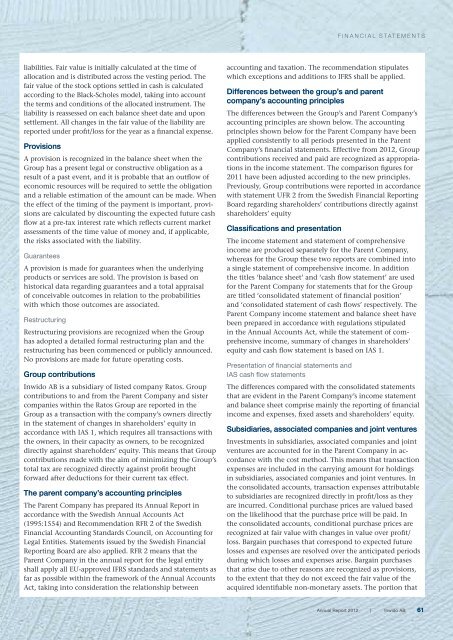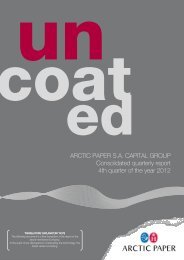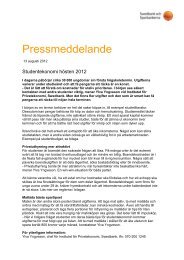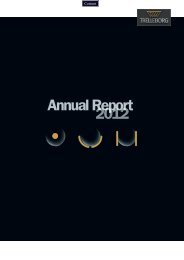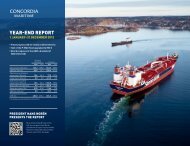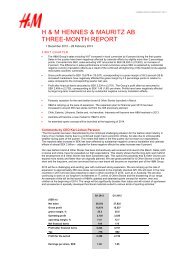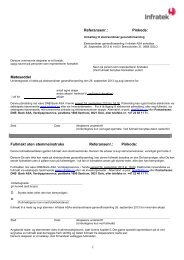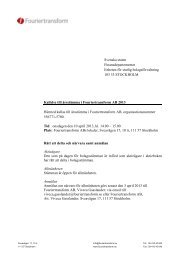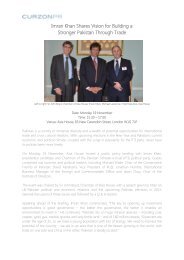Annual Report 2012 - Inwido
Annual Report 2012 - Inwido
Annual Report 2012 - Inwido
Create successful ePaper yourself
Turn your PDF publications into a flip-book with our unique Google optimized e-Paper software.
FINANCIAL STATEMENTS<br />
liabilities. Fair value is initially calculated at the time of<br />
allocation and is distributed across the vesting period. The<br />
fair value of the stock options settled in cash is calculated<br />
according to the Black-Scholes model, taking into account<br />
the terms and conditions of the allocated instrument. The<br />
liability is reassessed on each balance sheet date and upon<br />
settlement. All changes in the fair value of the liability are<br />
reported under profit/loss for the year as a financial expense.<br />
Provisions<br />
A provision is recognized in the balance sheet when the<br />
Group has a present legal or constructive obligation as a<br />
result of a past event, and it is probable that an outflow of<br />
economic resources will be required to settle the obligation<br />
and a reliable estimation of the amount can be made. When<br />
the effect of the timing of the payment is important, provisions<br />
are calculated by discounting the expected future cash<br />
flow at a pre-tax interest rate which reflects current market<br />
assessments of the time value of money and, if applicable,<br />
the risks associated with the liability.<br />
Guarantees<br />
A provision is made for guarantees when the underlying<br />
products or services are sold. The provision is based on<br />
historical data regarding guarantees and a total appraisal<br />
of conceivable outcomes in relation to the probabilities<br />
with which those outcomes are associated.<br />
Restructuring<br />
Restructuring provisions are recognized when the Group<br />
has adopted a detailed formal restructuring plan and the<br />
restructuring has been commenced or publicly announced.<br />
No provisions are made for future operating costs.<br />
Group contributions<br />
<strong>Inwido</strong> AB is a subsidiary of listed company Ratos. Group<br />
contributions to and from the Parent Company and sister<br />
companies within the Ratos Group are reported in the<br />
Group as a transaction with the company’s owners directly<br />
in the statement of changes in shareholders’ equity in<br />
accordance with IAS 1, which requires all transactions with<br />
the owners, in their capacity as owners, to be recognized<br />
directly against shareholders’ equity. This means that Group<br />
contributions made with the aim of minimizing the Group’s<br />
total tax are recognized directly against profit brought<br />
forward after deductions for their current tax effect.<br />
The parent company’s accounting principles<br />
The Parent Company has prepared its <strong>Annual</strong> <strong>Report</strong> in<br />
accordance with the Swedish <strong>Annual</strong> Accounts Act<br />
(1995:1554) and Recommendation RFR 2 of the Swedish<br />
Financial Accounting Standards Council, on Accounting for<br />
Legal Entities. Statements issued by the Swedish Financial<br />
<strong>Report</strong>ing Board are also applied. RFR 2 means that the<br />
Parent Company in the annual report for the legal entity<br />
shall apply all EU-approved IFRS standards and statements as<br />
far as possible within the framework of the <strong>Annual</strong> Accounts<br />
Act, taking into consideration the relationship between<br />
accounting and taxation. The recommendation stipulates<br />
which exceptions and additions to IFRS shall be applied.<br />
Differences between the group’s and parent<br />
company’s accounting principles<br />
The differences between the Group’s and Parent Company’s<br />
accounting principles are shown below. The accounting<br />
principles shown below for the Parent Company have been<br />
applied consistently to all periods presented in the Parent<br />
Company’s financial statements. Effective from <strong>2012</strong>, Group<br />
contributions received and paid are recognized as appropriations<br />
in the income statement. The comparison figures for<br />
2011 have been adjusted according to the new principles.<br />
Previously, Group contributions were reported in accordance<br />
with statement UFR 2 from the Swedish Financial <strong>Report</strong>ing<br />
Board regarding shareholders’ contributions directly against<br />
shareholders’ equity<br />
Classifications and presentation<br />
The income statement and statement of comprehensive<br />
income are produced separately for the Parent Company,<br />
whereas for the Group these two reports are combined into<br />
a single statement of comprehensive income. In addition<br />
the titles ‘balance sheet’ and ‘cash flow statement’ are used<br />
for the Parent Company for statements that for the Group<br />
are titled ‘consolidated statement of financial position’<br />
and ‘consolidated statement of cash flows’ respectively. The<br />
Parent Company income statement and balance sheet have<br />
been prepared in accordance with regulations stipulated<br />
in the <strong>Annual</strong> Accounts Act, while the statement of comprehensive<br />
income, summary of changes in shareholders’<br />
equity and cash flow statement is based on IAS 1.<br />
Presentation of financial statements and<br />
IAS cash flow statements<br />
The differences compared with the consolidated statements<br />
that are evident in the Parent Company’s income statement<br />
and balance sheet comprise mainly the reporting of financial<br />
income and expenses, fixed assets and shareholders’ equity.<br />
Subsidiaries, associated companies and joint ventures<br />
Investments in subsidiaries, associated companies and joint<br />
ventures are accounted for in the Parent Company in accordance<br />
with the cost method. This means that transaction<br />
expenses are included in the carrying amount for holdings<br />
in subsidiaries, associated companies and joint ventures. In<br />
the consolidated accounts, transaction expenses attributable<br />
to subsidiaries are recognized directly in profit/loss as they<br />
are incurred. Conditional purchase prices are valued based<br />
on the likelihood that the purchase price will be paid. In<br />
the consolidated accounts, conditional purchase prices are<br />
recognized at fair value with changes in value over profit/<br />
loss. Bargain purchases that correspond to expected future<br />
losses and expenses are resolved over the anticipated periods<br />
during which losses and expenses arise. Bargain purchases<br />
that arise due to other reasons are recognized as provisions,<br />
to the extent that they do not exceed the fair value of the<br />
acquired identifiable non-monetary assets. The portion that<br />
<strong>Annual</strong> <strong>Report</strong> <strong>2012</strong> | <strong>Inwido</strong> AB 61


